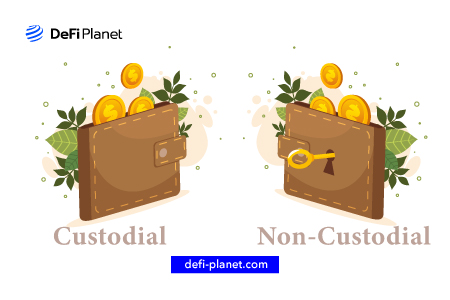Last updated on November 8th, 2022 at 01:17 pm
The significance of crypto wallets is becoming clearer by the day, especially since some of these wallets can contain other types of digital assets, such as non-fungible tokens.
There are various types of cryptocurrency wallets. Some are designed to be compatible with multiple chains, while others may be limited. They may be custodial in some cases and non-custodial in others.
A wallet may hold cryptocurrencies, collectibles, and NFTs, while others may store only one of the aforementioned digital asset types.
This article examines custodial and non-custodial wallets in-depth, as well as what to expect when utilizing them.
What is a Custodial Wallet?
The entity in charge of the private keys is a significant difference between custodial and non-custodial wallets. Custodial wallets are designed to entrust control of the private keys in the hands of a third party, which may be a cryptocurrency exchange.
This type of wallet indicates that there is a centralized entity in charge of the protection and storage of digital assets.
For example, if a user wishes to swap a cryptocurrency on a centralized exchange, they must first deposit their tokens to the custodial wallet and then make the swap.
They are required to do the same if they wish to engage in margin trading, futures trading, and other forms of crypto trading on a centralized trading platform.
Typically, the standard account on a centralized exchange is a custodial wallet. It deprives the user of complete control over their digital assets and prevents them from storing private keys or seed phrases.
This may be an answer to a new user’s prayers if they have problems remembering the seed phrase of a non-custodial wallet, as they are not required to memorize a string of random words or numbers. They only need to remember their log-in information, which includes their email address and password. If they forget their password, they can always follow the instructions to reset it. A non-custodial wallet does not have this option. When a user forgets their seed phrase, they are unable to access their wallet or the digital assets stored in it.
Custodial wallets, particularly those on centralized exchanges with the “next of kin” option, enable specified parties to access digital assets after the account has been inactive for some time. This is not very prevalent nowadays.
By choosing a custodial wallet, the user agrees to entrust their private keys to a centralized authority, which means that if an attack occurs, the user may lose their funds. When a centralized wallet is hacked or exploited, the exchange may fully or partially compensate its users. This may not occur in all cases.
Using a custodial wallet has several advantages, but it also has some disadvantages.
Some exchanges have frozen or blocked consumers’ access to their digital assets in their accounts in the past.
For instance, Binance blocked the custodial wallets of 281 Nigerians, causing a stir in Twitter’s crypto community.
What is a Non Custodial Wallet?
Non-custodial wallets are the polar opposite of their custodial counterparts.
Because the user controls their private keys, trust is not delegated to a third party in a non-custodial wallet. Trust Wallet and Metamask are two examples of non-custodial wallets.
Users may not be prevented from conducting transactions due to the lack of a centralized authority. They have the option of swapping their tokens whenever they desire. Non-custodial wallets are usually free of restrictions.
Although users retain full control, using a non-custodial wallet isn’t for everyone. A crypto enthusiast, for example, must protect their seed phrases. If they lose it, they will be unable to access their wallet or digital assets.
The wallet’s security is in the hands of the crypto user, not a centralized authority. Individuals are compelled to store their seed phrases in a private and secure location.
Types of Non-Custodial Wallets
Non-custodial wallets come in different forms.
The browser-based version may be implemented as a browser extension. A classic example is Metamask.
Second, it may be a hardware wallet. This type allows users to store their crypto assets in a location that is not usually connected to the internet. This is also referred to as a “cold storage system.” An example is Ledger.
Finally, non-custodial wallets may be desktop devices that allow users to manage their assets on a desktop device. The application is usually downloaded on a desktop computer. An example is Exodus.
Sometimes, a non-custodial account may be mobile compatible, allowing users to navigate their asset management portfolio through a decentralized app on their mobile devices.
Factors To Consider Before Using A Crypto Wallet
Some factors should be considered before choosing a crypto wallet to ensure that crypto holdings are protected. Always do
your research before choosing a crypto wallet
The information provided below is not an exhaustive list of factors to consider before storing and managing cryptocurrency holdings in a custodial or non-custodial wallet.
• Development team
Vetting the development team allows the crypto enthusiast to learn if they are anonymous, as well as their experience and pedigree.
Some development teams are well-known for their previous accomplishments, which lends credibility to whatever project they work on.
If a group of anonymous developers is supporting the project, this could be a red flag.
• Authenticity of application
Scammers have been known to clone the apps of reputable crypto wallets.
They try to persuade their intended victims to download fake apps in order to steal their digital assets.
These phony apps can sometimes be found in legitimate app stores.
They may also appear on the first page of a search engine result in some cases.
They’re sometimes found in the advertisement section of a search engine result.
• Reviews
It is a good idea to read reviews about a crypto wallet before using it, especially if it is a new one. It is worth noting that some reviews may have been fabricated. Looking for reviews across a variety of platforms can help you get a better idea of what to expect when using the crypto wallet. Reviews help answer questions such as; Are there any cases of users being defrauded? Is the user interface user-friendly?
• Security information
When considering a crypto wallet, it is advisable to consider security information. The security architecture of a wallet determines if it will be an easy target for hackers or if there are systems to shield it.
How to Safeguard Your Crypto Wallets
There are certain techniques that users may employ to increase their security and prevent unauthorized users from accessing their wallets, whether they are custodial or non-custodial.
Opt for strong passwords.
Non-custodial wallets such as Trust Wallet and Metamask allow users to create passwords to restrict access.
Before anyone can access the wallet, they must first enter the password they set.
Non-custodial wallets often only request the seed phrase when a user wants to access their wallet on a new device.
The password, on the other hand, is required each time a person attempts to access their wallet.
The same holds for custodial wallets. Binance users, for example, are required to provide their log-in details, which include their email address and password, before they can access their accounts.
Using a strong password reduces the likelihood of someone guessing it.
It is best to avoid using the names of loved ones or significant dates as passwords.
Beware of suspicious links.
Cyber-attacks have evolved to the point where a user’s crypto assets may be lost as a result of clicking on a malicious link.
Some of these URLs contain malware that becomes embedded in the user’s device, allowing the scammers to collect information associated with the victim.
If a user enters log-in details or passwords, the malware instantly copies them and transmits the stolen information to the malware creator.
The scammer could then use the information to attempt to steal digital assets.
Use two-factor authentication (2FA)
2FA adds an extra layer of security to a cryptocurrency wallet. Using this makes gaining access to a wallet and the digital assets stored in it difficult, even if the scammer has the log-in details. Typically, 2FA notifies the user that their wallet or account is about to be breached.
In Conclusion,
- Crypto wallets are classified as custodial or non-custodial.
- Non-custodial wallets give the holder control over the private keys and digital assets.
- Custodial wallets entrust the security to a third party.
- Non-custodial wallets could be mobile, desktop, hardware, or browser wallets.
- When deciding on a crypto wallet to use, there are a few factors to consider to make the process seamless.
- Some cryptocurrency wallets are NFT-compatible.
If you would like to read more news articles like this, visit DeFi Planet and follow us on Twitter, LinkedIn, Facebook, and Instagram.






















